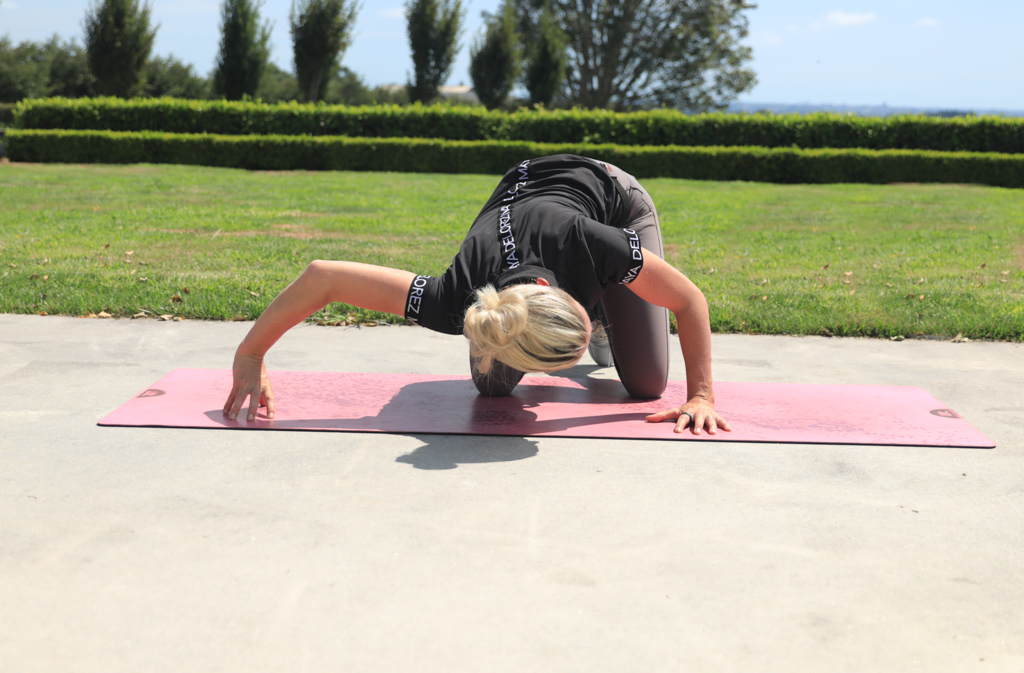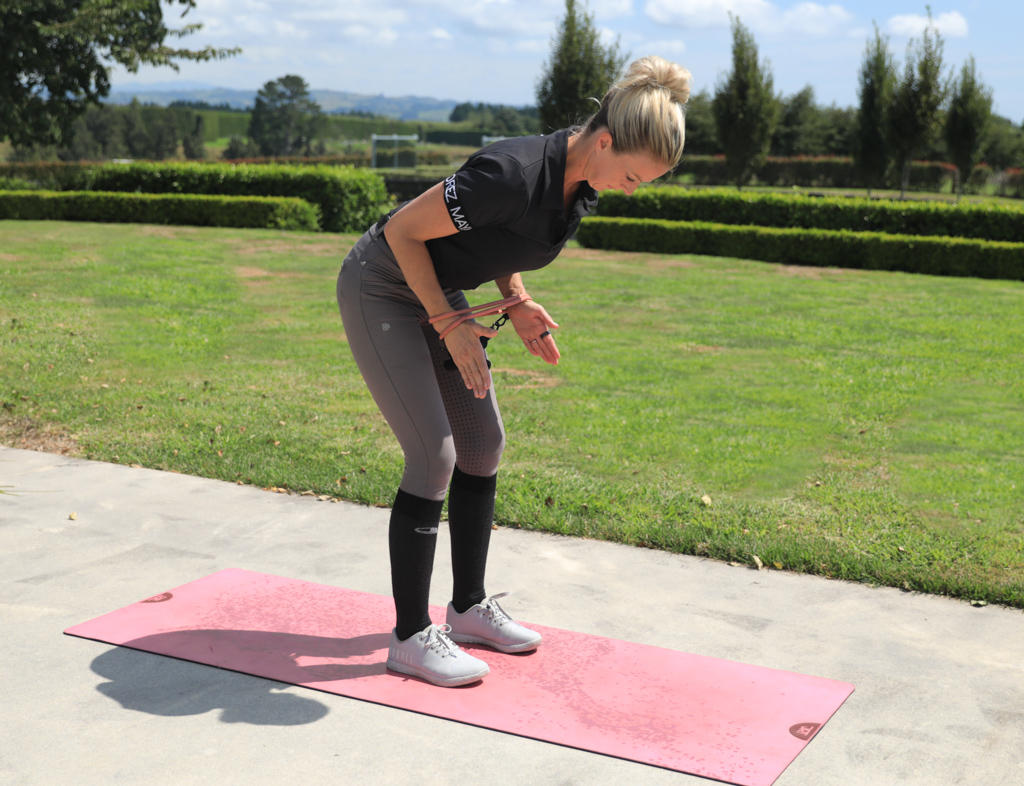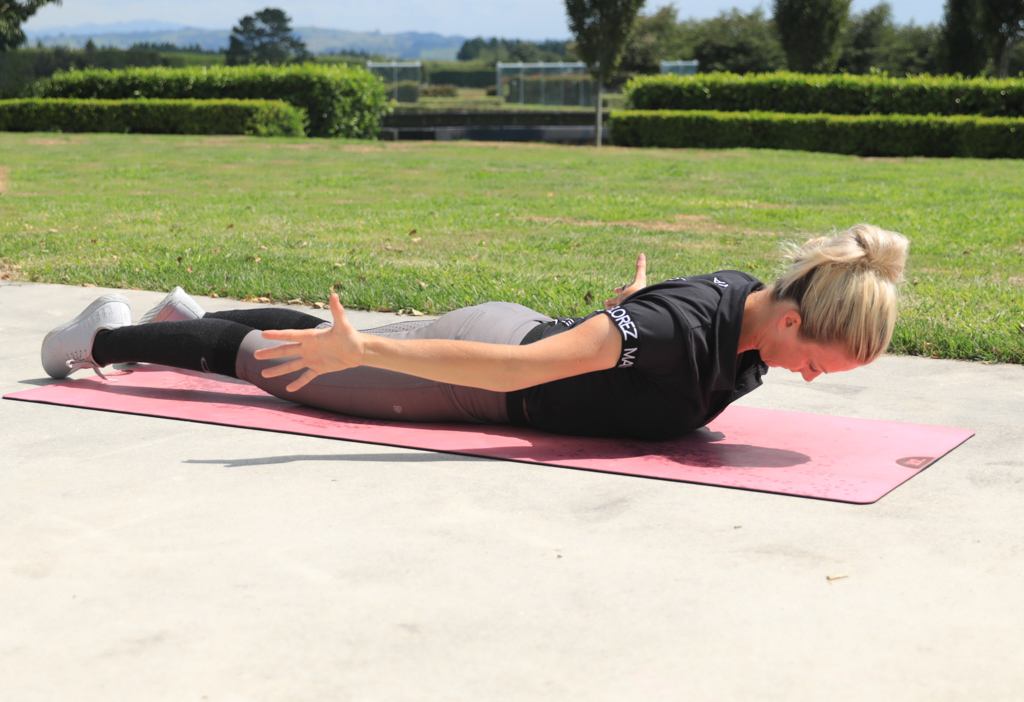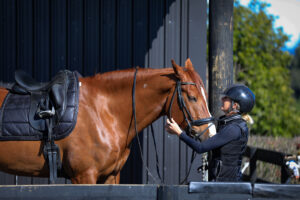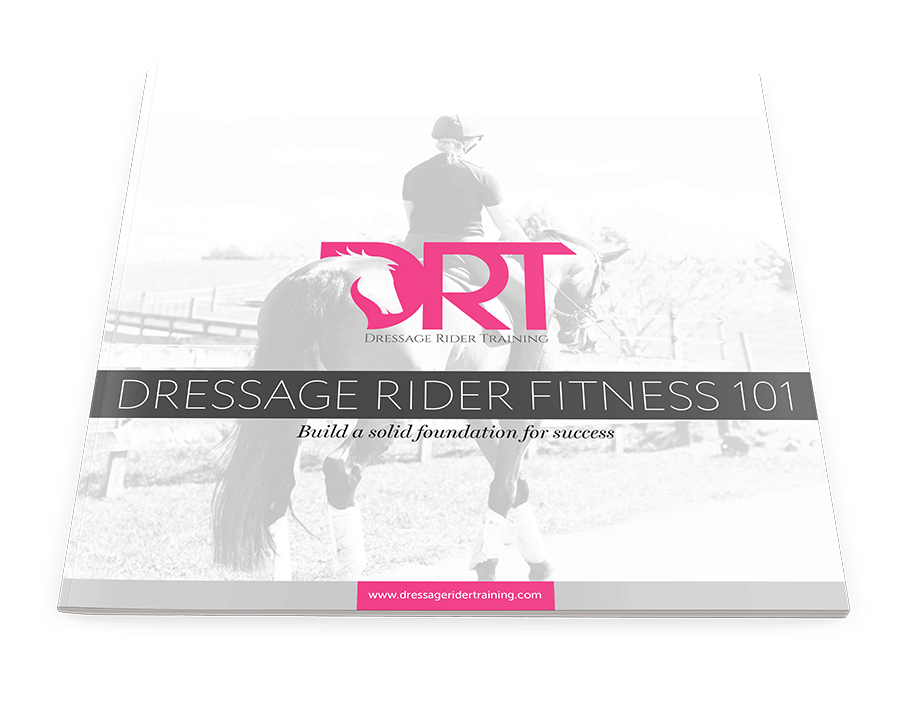Upper Cross Syndrome In Dressage Riders
Upper cross syndrome and how it relates to your posture in the saddle. Learn how to improve it and prevent it.
Upper cross syndrome is one of the most common postural problems in both young and old. You may not have heard of the term upper cross/upper crossed syndrome, but you’ve probably seen it. It often goes hand in hand with lower cross/lower crossed syndrome.
UCS is often caused by poor posture over an extended period of time. Which results in rounded shoulders, head in front of the body and an apparent curve in the neck and upper back.
Extremely common in today’s modern society with days staring at computer screens or phones and/or long hours spent behind a desk or driving.
Quite commonly seen in riding too and when reflected in the saddle causes the rider to tip forward and can result in a bobbing of the head and of course rounded upper back.
What is upper cross syndrome?
The body works as an entire unit, everything is connected. When one muscle becomes weak, another muscle takes over the work.
In the case of upper cross syndrome, mid-back muscles (serratus and lower trapezius) become very weak. So as a result, the pectoral and neck muscles then tighten.
This imbalance can then create pain throughout the upper body, including shoulder pain and neck pain, as well as a reduced range of motion.
The imbalance created from the weakening and lengthening of the posterior upper back and neck muscles, combined with the tightening and shortening of the opposing anterior pectoral (chest) and neck muscles is what creates this upper cross syndrome and this imbalance can then lead to joint dysfunction.
What causes upper cross syndrome?
A sendantary life is the main cause of upper cross syndrome. The lack of strength and suppleness combined with long hours of sitting at a computer, watching television, or even long hours driving can contribute to bad posture.
The lack of adequate strength and suppleness to balance the body from everyday life combined with this poor posture repeated day in and day out over weeks, months and years causes the weakening of the rhomboid and neck flexor muscles while tightening and shortening the pectoral and upper trapezius muscles.
This pattern of opposing muscles groups is what is known as the “cross” pattern where the condition gets its name. This imbalance causes the spine to pull forward, significantly increasing the amount of stress on the supporting muscles.
While this sedentary lifestyle is the leading cause, it can also be seen in athletes too, with the overuse of muscles in one area without the strengthening and support happening in others.
If your natural tendency is to be in this forward position and you don’t do the work to strengthen the opposing muscle groups, this position will only increase over time.
What are the symptoms?
Upper cross syndrome can be quite visible to see and in most cases will begin with the rounding of the shoulders and the neck and head being pulled forward.
The spine then will also start to curve inwards near the base of the neck and outwards through the upper back and shoulders.
This pull in opposing direction then creates stress on the supporting muscles, tendons, joints and ligaments. Which over time can cause headaches, neck pain or strain in the back of the neck, chest pain and tightness, pain in the upper back, especially the shoulders and through the shoulder blades.
Is upper cross syndrome going to affect my dressage performance?
Upper cross syndrome will gradually develop and can over time lead to more of a chronic condition leaving significant muscle imbalances.
If this poor alignment is then left and you then add the forces of the horses movement to those muscle imbalances without correct alignment, this can then reduce your overall performance and ability to move with your horse. Not to mention create niggles and aches and pain from overuse of the wrong muscle groups.
Many riders ride with this upper cross syndrome and many will be unaffected, however depending on the level of your riding and the goals you wish to achieve will depend on whether or not this poor posture and alignment will hold your back and hinder your growth and performance as a rider.
Treatment for upper cross syndrome
Like most muscle imbalances the best way to improve them is through strengthening what is weak and lengthening what is tight. Using preventative stretches, exercises and taking the time to improve overall posture.
Upper Cross Syndrome treatment involves the strengthening of the weakened posterior musculature and stretching of the tight anterior musculature. While also taking into consideration factors that may have promoted this posture in the first place and looking at ways to improve them.
Posture is something that we can improve. But often ignored, in the long run though if ignored for too long it can limit your daily activities and general ability to enjoy life, not to mention riding.
Symptoms of Upper cross syndrome
- Rotation or Abduction of Scapulae
- Hunching of the Thoracic Spine
- Kyphosis
Besides having postural changes, the imbalanced muscles also strain their surrounding joints, bones, muscles, and tendons. So, you can also experience the following:
- Headache
- Neck pain
- Upper back and shoulder pain
- Chest pain
- Weakness in front of the neck while the strain on its back
- Fatigue
- Low back pain
- Jaw pain
Stretches to improve upper cross syndrome
To help you work on your posture here are some simple stretches to stretch what is tight so that you can strengthen what is weak.
Often it is a good idea to stretch first to allow your position to open up and the proper recruitment be able to happen through the weaker muscles you are wanting to strengthen.
Prone chest stretch
Laying on the ground, reach back and link your hands together, if you can’t quite reach, try holding a tea towel in both hands as close as you can together.
Then roll your shoulders back and squeeze shoulder blades together.
Hold for 10-20 seconds
Childs pose side reach
Start by kneeling on the ground, join you toes together and take your knees as wide as you can, then sit back towards your heels while reaching hands forward.
Take your left hand and place it on top of your right as your reach your right hand forward to about the 1-2 o’clock position ( if 12 was straight forward).
Turn your head towards your right and think of lowering your left armpit towards the ground to get a stretch under your armpit and down through the side of your body.
Hold for 10-20 seconds and repeat on the other side.
Childs pose twist
Sit up as above, but place your left hand into the small of your back as you reach your right hand forward.
Turn your head to the left and roll your left shoulder back.
Think of pushing your right armpit towards the floor to get a stretch under your right armpit.
Hold for 10-20 seconds and repeat on the other side.
Butchers block with foam roller
Start by kneeling on the ground and place your elbows onto the foam roller. If this isn’t possible, you can use a chair or the edge of your couch.
Join your hands behind your head and lower your chest towards the ground as you feel a stretch under your armpits and down into your lats.
Hold for 10-20 seconds.
Scorpion stretch
Start laying on the ground on your front and reach your left arm out to 45 degrees.
Then roll onto your side and allow your right leg to drop behind you as you lift your chest and turn your shoulders.
Feel this stretch through the front of your chest and also get a nice twist through your spine.
Standing chest stretch
Standing with your legs together, reach back behind your and link your hands together. If you can’t quite reach, use a towel and hold on this with your hands as close together as possible.
Roll your shoulder back and down and squeeze shoulder blades together.
Hold for 10-20 seconds
Arm circles
Standing with your feet together and neutral spine, circle your left arm backwards.
Think of really reaching back as far as you can and reaching through the entire circle that your arm makes.
Do 10 circles on each arm while maintaining neutral spine to allow the movement to just come from the shoulder.
Kneeling pec stretch
Start on by kneeling on the ground and placing your right arm on the floor as far away as you can and onto your finger tips.
Then lift your elbow up high and lower your shoulder towards the ground while keeping elbow up.
Try lowering your shoulder towards the floor as you turn away from it to get a stretch through your shoulder.
Supine twist
Laying onto the ground on your back, reach your left arm up behind you to 45 degrees.
Then let your legs drop over to your right side while you use your right hand to anchor your legs.
As you turn look back towards your left arm and really think about pressing both shoulders into the ground and feel this open up your spine and upper back.
Hold for 10-20 seconds
Strengthening Exercises For Better Posture
Now that you have stretched what is tight, let now spend time strengthening what is weak to help improve overall posture and alignment.
Bent over tube rows
Start standing with your feet hip distance apart and in your neutral spine position.
Place a tube around both of your hands and have your palms facing each other.
Pull your elbows back by your sides and as you do this roll your shoulders back and down and squeeze shoulder blades together.
Lengthen your arms back down to the ground while keeping your shoulders back and down, then pull elbows back again by your side. This is one rep.
Have tension on the resistance band by pulling your hands apart. I am using a DRT band that I have doubled up and linked the handles together.
Think of having a long straight spine and lengthening the back of your neck as you do this and look to the ground about 1 m in front of you, so your spine is straight and long.
Repeat this 12-15 times.
Kneeling band rows
Place the resistance band around your hands with enough resistance to allow you to pull your hands apart and feel the tension between your shoulder blades. I am using a DRT band again with the handles joined together.
In this position, straighten your arms out in front and then pull your elbows back again towards your side as one movement. Keep the tension there to feel the work in the shoulder blades.
Ensure you have rolled your shoulders back and down to set up your good posture as you work those postural muscles.
Repeat 12-15 times
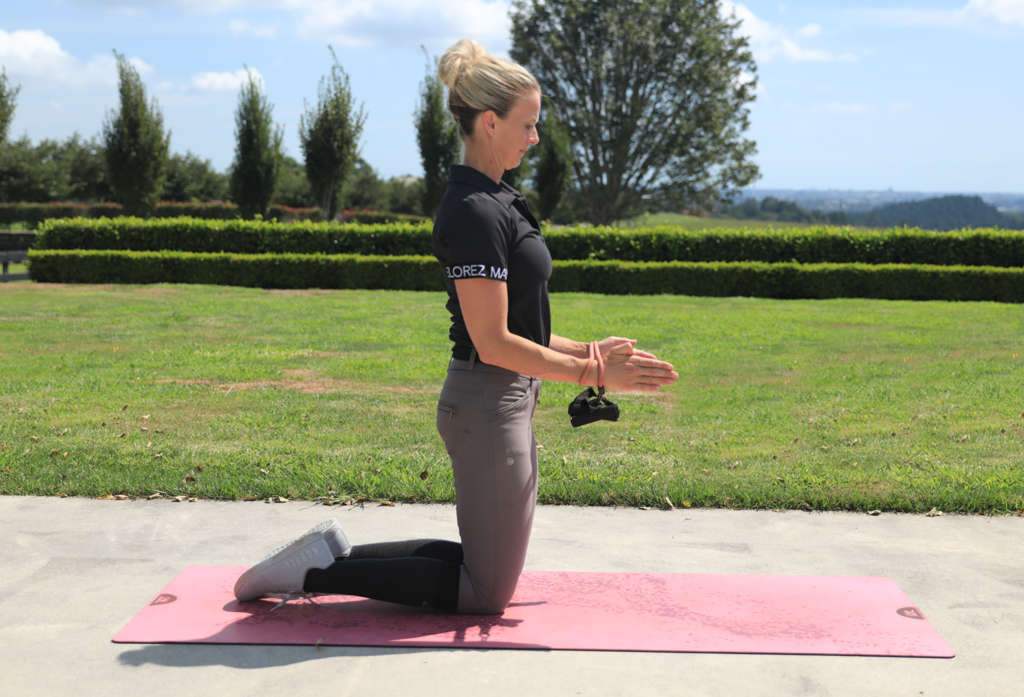
Seated band pull aparts
Kneeling on the ground or sitting on a chair, set up as above with the resistance band around your hands.
Then roll your shoulder back and down to set your good upper body posture.
In this position imagine you are holding a pair of reins and then open your hands a little wider while keeping elbows by your side and then back in front of you again.
Feel the squeeze happen through the shoulder blades as you open up and then try and maintain that engagement as you reset again.
Repeat 12-15 times.
Prone band lat pull downs
Laying on the ground, take a hold of the band and pull the resistance band apart to place some tension on it and to engage your shoulder blades and lats.
Then straighten your arms up over your head and pull then back down again.
Tuck your chin and lengthen the back of your neck and try and keep the tube as close to your chin as possible as your pull it down towards your chest.
Engage your glutes as you do this to protect your lower back and you can flatten your feet on the ground if you find it too much for your back.
Repeat 12-15 times.

ATY position one
Laying on the ground, lengthening the back of your neck, slightly lift your chest and reach your hands back by your sides, imagining you are making the letter A with your body.
In this position, engage your glutes and pulse your arms for 20 quick pulses.
Ensure you are rolling your shoulders back and down while squeezing shoulder blades together.
ATY position two
Set up as above, but this time you are making the letter T.
So bring your arms out the side and again pulse for 20 pulses while lengthening the back of your neck and engaging your glutes.
ATY postion three
You guessed it, this time you are making the letter Y. So reach your arms up over your head and squeeze shoulder blades together.
Pulse for 20 and really think of rolling shoulders back and down.
If you find it too much with your chest lifted here, rest your forehead on the ground and do very small pulses just off the ground.
Upper locust pull downs
Stay laying on the ground and begin in the Y position with your arms out at 45 degrees.
Squeeze your elbows back and down towards your ribs as you roll your shoulders back as far as you can and squeeze shoulder blades together.
Repeat this 12-15 times.
So there you have a great selection of both stretches and exercises to help improve your upper body posture and prevent upper cross syndrome.
Try doing these 3-4 times through as a circuit at least a couple of times per week to make changes to your posture.
Try these exercises out with the ones here for lower cross syndrome and you have an excellent place to start in helping your overall posture and ultimately your riding posture too.
Tips for preventing upper crossed syndrome include:
- limiting time spent in poor posture. Pay attention to how you sit and what you do throughout your day.
- take breaks throughout your day if you have a desk job or spend a lot of time driving. For every 2 hours of sitting, do this circuit at least once.
- get enough cardiovascular exercise, ideally 30 minutes daily or 10,000 steps of walking per day
- be aware of motions, movements, or activities that worsen symptoms and avoiding them for as long as discomfort continues and put the work in to counteract those motions/movements.
- do stretches that target the tight muscles
- doing strengthening exercises to target weakened muscles
- making sure the steering wheel and or desk are all set up ergonomically to prevent worsening your posture.
- Correcting or practicing proper posture as often as you can.
- Actively aging and incorporating strength training in to your life.
Want more stretching you can do to help your posture? Check out these articles.
Lower cross syndrome in dressage riders
Strength training for dressage riders
Glute Strengthening Exercises For Riders
5 Stretches That Every Dressage Rider Should Do
6 Dressage Exercises To Help Improve Your Riding Posture
Stretches For Riders With Tight Shoulders And Upper Back
Want some help with your riding? Check out our sister site Dressage Horse Training
Improve walk canter transitions
Dressage Rider Training Program
Join other participants on our 12-week 'step-by-step' online rider
training program. Improve the 5 components of your riding.
Only available 3x per year.
see full details & register your interest








